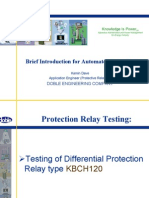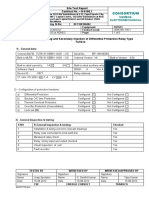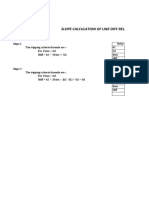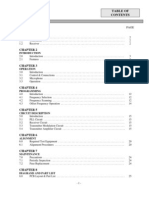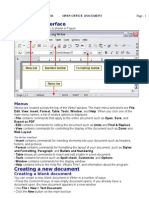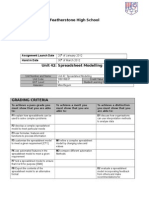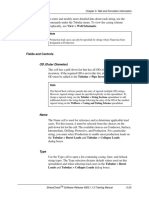T R 1 - Testing Distance Relays
T R 1 - Testing Distance Relays
Uploaded by
Carlos Cordero HerreraCopyright:
Available Formats
T R 1 - Testing Distance Relays
T R 1 - Testing Distance Relays
Uploaded by
Carlos Cordero HerreraOriginal Description:
Original Title
Copyright
Available Formats
Share this document
Did you find this document useful?
Is this content inappropriate?
Copyright:
Available Formats
T R 1 - Testing Distance Relays
T R 1 - Testing Distance Relays
Uploaded by
Carlos Cordero HerreraCopyright:
Available Formats
DVS3 & 50A-3PH Application
TESTING DISTANCE RELAYS
1. Introduction ................................ ................................ ................................ ........... 2
2. Distance Relays and Impedance Characteristics................................ ................ 3
2.1 Distance Relay Types ................................ ................................ .................. 3
2.2 Primary System Impedance and Secondary Impedance.............................. 4
2.2.1 Secondary Impedance................................ ................................ ...... 4
2.2.2 Primary Impedance ................................ ................................ .......... 4
2.2.3 Conversion Between Primary and Secondary Impedances .............. 4
3. Distance Relay Test Strategy................................ ................................ ................ 6
3.1 Current and Voltage................................ ................................ ..................... 6
3.2 Test Vectors................................ ................................ ................................ . 6
3.3 Applying Test Points/Vectors to the Relay ................................ ................... 7
4. Test Point/Vector Calculation................................ ................................ ............... 9
4.1 Conversion from Voltage, Current and Phase to Impedance ....................... 9
4.2 Conversion from Impedance to Voltage, Current and Phase ....................... 9
4.2.1 Impedance Using Complex Notation ................................ .............. 10
5. Test Procedures ................................ ................................ ................................ .. 11
5.1 Calculating the Test Points ................................ ................................ ........ 11
5.2 DVS3 and 50A-3PH Connections ................................ .............................. 11
5.3 Determining Zone Boundaries ................................ ................................ ... 13
5.3.1 Determining Zone Boundaries by Continuous Variation of Impedance
................................ ................................ ................................ ....... 13
5.3.2 Determining Zone Boundaries Using Discrete Steps of Impedance 14
5.4 Zone Timing Tests ................................ ................................ ..................... 15
6. Distance Test Spreadsheet................................ ................................ ................. 17
6.1 System Parameters ................................ ................................ ................... 17
6.2 Conversion from Impedance to V, I and Test Values .............................. 18
6.3 Conversion from V, I and Test Values to Impedance .............................. 19
6.4 Display of Results on R-X Diagram................................ ............................ 19
Title: DVS3 & 50A-3PH Application Note - Distance Relays v1.00.doc
Author: IDWL Date: 18/8/03 Revision: 1
Page 2
1. Introduction
The DVS3 mk2 and 50A-3PH may be used to generate impedances for testing distance relays.
Using these units the relay zone boundaries may be tested and the trip time of each zone
ascertained.
In testing distance relays, the 50A-3PH acts as a simple current source, supplying 3 phase current
to the relay under test and a phase reference to the DVS3. The magnitude and phase angle of the
voltage is controlled on the DVS3 to give the desired impedance. The impedance may either be
varied continuously or in steps.
An Excel spreadsheet is available to accompany this application note to simplify conversion
between impedance values and test voltages and currents.
Title: DVS3 & 50A-3PH Application Note - Distance Relays v1.00.doc
Author: IDWL Date: 18/8/03 Revision: 1
Page 3
2. DISTANCE RELAYS AND IMPEDANCE CHARACTERISTICS
2.1 Distance Relay Types
Distance relays are impedance relays they operate on the ratio and phase angle between the
system voltage and current. The relay operating characteristics are usually represented on an RX
diagram as a circle or quadrilateral. Many distance relays have multiple areas of operation, or
zones. Points on the RX diagram inside a zone cause the relay to trip. Time delays can usually be
set for different zones, with increasing delays set for zones relating to sections of line further away
from the relay.
RX Diagram
100
80
60
40 Mho
X
20
0
-20 0 20 40 60 80 100
-20
R
Figure 1. Example RX Diagram Mho Relay
Relays with other impedance characteristics are also available, including the quadrilateral
characteristic implemented by many microprocessor relays.
50.00
40.00
30.00
20.00 Zone 1
Zone 2
10.00
Zone 3
0.00 Zone 4
-100.00 -80.00 -60.00 -40.00 -20.00 0.00 20.00 40.00 60.00 80.00 100.00 PSIA
-10.00
-20.00
-30.00
Figure 2. Example RX Diagram Quadrilateral Relay
Title: DVS3 & 50A-3PH Application Note - Distance Relays v1.00.doc
Author: IDWL Date: 18/8/03 Revision: 1
Page 4
2.2 Primary System Impedance and Secondary Impedance
The relay may work in terms of primary system impedance or secondary impedances. In the
examples in 2.2.1 and 2.2.2 a system will be considered with the following parameters:
System voltage: 230kV
System rated current: 1000A
VT Ratio: 230kV/110V
CT Ratio: 1000/1A
Line positive sequence impedance 48.42 79.41
2.2.1 Secondary Impedance
Secondary impedances are calculated directly from the voltages measured on the secondaries of
the protection VTs and CTs the voltages and currents that the relay actually sees. In this case,
the rated VT secondary voltage is 110V, and the CT nominal secondary current is 1A. If secondary
impedances are used, all system impedances must be scaled to secondary impedances before
being used in relay setting calculations.
Many older distance relays work in terms of secondary voltages, currents and impedances.
2.2.2 Primary Impedance
Primary impedances are referred to the actual system voltages and currents on the lines monitored
by the relay. For a relay to work in terms of primary impedance the relay must be programmed with
the VT and CT ratio. The primary voltages, currents and impedances are calculated by the relay
from the CT and VT secondary values and the CT and VT ratios.
Most numerical distance protection works in terms of primary system voltages, currents and
impedances.
2.2.3 Conversion Between Primary and Secondary Impedances
To convert a primary impedance to a secondary impedance or vice-versa the equations below may
be used. The equations hold true for impedances expressed as complex values or as
magnitudephase values. In the case of the magnitudephase values, the phase angle of the
impedance is unchanged by the calculation.
RatioVT
Z sec = Z pri .
RatioCT
RatioCT
Z pri = Z sec .
RatioVT
Title: DVS3 & 50A-3PH Application Note - Distance Relays v1.00.doc
Author: IDWL Date: 18/8/03 Revision: 1
Page 5
e.g The line positive sequence above is 48.42 79.41 as a primary system impedance. To
calculate this expressed as an impedance referred to the CT & VT secondary, carry out the
following calculation:
RatioVT
Z sec = Z pri .
RatioCT
230000 / 110
Z sec = 48.42
1000 / 1
Z sec = 101.379.41
Title: DVS3 & 50A-3PH Application Note - Distance Relays v1.00.doc
Author: IDWL Date: 18/8/03 Revision: 1
Page 6
3. DISTANCE RELAY TEST STRATEGY
The basic strategy in testing a distance relay with the DVS3 and 50A-3PH is to generate a series of
test impedances that check the locations of the boundaries of the zones under test. Unless
separate contacts are available for each zone of operation, the operation of a particular zone is
differentiated during test by the trip time of the relay.
The relay is tested by applying a series of impedances to the relay by leaving the current fixed and
altering the voltage magnitude and phase angle using the DVS3. By typing in values for the
voltage, step changes of impedance can be generated which step from outside of the trip zone of
the relay to inside of any of the zones. The trip time of the relay then indicates which zone has
operated. A series of points can be defined which will exercise the relay and verify the position of
the zone boundaries.
3.1 Current and Voltage
Used together, the 50A-3PH and DVS3 mk2 are able to generate the impedances required to test a
distance relay. In many cases, the required impedance could be generated by different
combinations of current and voltage. It is, however, more convenient when testing to set the
current on the 50A-3PH to a suitable value (e.g. In) and control the impedance using the voltage
controls on the DVS3. This allows steps of impedance to be generated very easily. There may,
however, be impedances that cannot be generated without increasing the current. This is
particularly true of older relays where the relays is unable to accurately operate with low input
voltages.
3.2 Test Vectors
The simplest way to test a distance relay using a DVS3 is use the concept a test vector passing
through the zero impedance point (the centre of the RX diagram). This allows any impedance along
the line to be generated by changing just the voltage on the DVS3. Points on the test vector may
then be chosen to verify the boundaries of the zones on the relay. To fully test the relay, it may be
necessary to use four or more vectors on different angles. Figure 3 shows a single test vector with
test points at 5% above and below each zone boundary on the vector.
Title: DVS3 & 50A-3PH Application Note - Distance Relays v1.00.doc
Author: IDWL Date: 18/8/03 Revision: 1
Page 7
60.00
50.00
40.00
30.00
Zone 1
20.00 Zone 2
Zone 3
10.00
Zone 4
0.00 PSIA
-100.00 -80.00 -60.00 -40.00 -20.00 0.00 20.00 40.00 60.00 80.00 100.00 Test vector 1
-10.00
-20.00
-30.00
-40.00
Figure 3. Test vector on quadrilateral relay characteristic
To test a relay exhaustively, test vectors must be set up to verify all boundaries of the relay zones.
This is necessary for commissioning, but may not be required for maintenance testing, where a few
vectors will verify operation of the relay and the position of the boundaries.
3.3 Applying Test Points/Vectors to the Relay
In applying test values to a relay, it is important to remember that the initial test point must lie
outside of all of the zones, or the relay will trip erroneously before the test impedance is applied.
60.00
A
50.00
B
40.00 C
D
Zone 1
30.00 E Zone 2
F Zone 3
20.00 G Zone 4
H PSIA
Test vector 1
10.00
0.00
-10.00 10.00 30.00 50.00 70.00 90.00
-10.00
Figure 4. Test points to be applied to relay
Title: DVS3 & 50A-3PH Application Note - Distance Relays v1.00.doc
Author: IDWL Date: 18/8/03 Revision: 1
Page 8
The sequence to apply a test impedance to the relay is:
Set the phase angle for the test vector on the DVS3. This remains constant
throughout the test on a particular vector.
Switch on the current on the 50A-3PH, and set each phase to the test current (In or
other suitable value).
Switch on the voltage on the DVS3.
Apply an initial impedance to the relay outside all zones (point A on figure 4) by setting
the voltage on the DVS3 to an appropriate value. This point is always on the angle of
the test vector, and placed outside the outermost zone of operation.
Apply the test impedance (for example point B on figure 4) by entering the new
voltage on the test vector using the keypad on the DVS3. The relay will trip in the
time appropriate for the zone, and the trip time will be displayed on the DVS3.
Reset the DVS3 to the initial out of zone impedance ready for the next test point. The
DVS3 timer will show the relay reset time.
After each test point it is important to return the impedance to the out of zone impedance to reset
the relay ready for the next test point. Detailed instructions may be found in section 5 Test
Procedures.
Title: DVS3 & 50A-3PH Application Note - Distance Relays v1.00.doc
Author: IDWL Date: 18/8/03 Revision: 1
Page 9
4. TEST POINT/VECTOR CALCULATION
Test stimuli applied to the relay from the DVS3 and 50A-3PH are applied in terms of current (I),
voltage (V) and phase (). It is therefore necessary to be able to convert impedances to V, I and
and vice versa.
4.1 Conversion from Voltage, Current and Phase to Impedance
Conversion from voltage, current and phase information is a simple application of Ohms law.
Assuming that the current has a phase angle of 0, the impedance will have the same phase angle
as the voltage. The voltage magnitude can be calculated from Ohms law:
V
Z =
I
For example, if we inject a current of 1A and apply a voltage of 100V at 29, the following
impedance is generated:
100
Z =
1
= 100
The phase angle is unchanged at 29, so the complete impedance is 10029.
4.2 Conversion from Impedance to Voltage, Current and Phase
Using the 50A-3PH and DVS3, the current phase angle is again 0, and the voltage phase is the
same as that of the impedance. A suitable value of current needs to be chosen (often In for the
relay), and then the voltage may be calculated:
V = I .Z
For example, if the impedance to be generated is 10030 (100 at 30) and the test current is
1A, the required voltage may be calculated as follows:
V = I .Z
= 1A.100
= 100V
The phase angle of the voltage will be the same as the phase angle of the impedance, so the
voltage is 10030V.
Title: DVS3 & 50A-3PH Application Note - Distance Relays v1.00.doc
Author: IDWL Date: 18/8/03 Revision: 1
Page 10
4.2.1 Impedance Using Complex Notation
Impedances expressed in complex notation need to be converted to magnitudephase notation.
For example, an impedance of 86.6 + j50 is first converted to magnitudephase notation:
Z = 86.6 2 + 50 2
= 100
50
= tan 1
86.6
= 30
The voltage and phase angle may then be calculated as in section 4.1.1.1. Alternatively, the
voltage may be calculated in complex notation, and then converted to magnitude and phase values.
Title: DVS3 & 50A-3PH Application Note - Distance Relays v1.00.doc
Author: IDWL Date: 18/8/03 Revision: 1
Page 11
5. TEST PROCEDURES
It is advisable to decide on the number of test vectors and test points required to effectively test the
relay before starting to test. These points can then be converted to currents, voltages and phase
angles using the calculation spreadsheet. The calculated test points are then applied to the relay in
turn and the operation of the relay verified. If the relay impedances are given as primary system
values, these will have to be converted to impedances referred to the VT and CT secondary values.
5.1 Calculating the Test Points
Before calculating the test points, it is necessary to decide how far inside or outside of a zone a test
point will be. This can be decided on the accuracy required for the results of the position of the
boundary. If it is acceptable to verify points either side of the zone boundary, offsets from the test
value may be chosen depending on the accuracy required (e.g. 3% of zone boundary impedance
or 1). If it is necessary to determine the zone boundary value more accurately, it may be better
to use the procedure in section 5.3 to determine the zone boundary and perform timing tests
separately at an arbitrary point in each zone.
5.2 DVS3 and 50A-3PH Connections
Figure 5 shows the connection between the 50A-3PH, DVS3 and the relay under test.
Relay Relay Relay Relay
Relay
current current current Distance Relay contacts
voltage
coil A coil B coil C coil
1.000A 1.000A 1.000A
0.0 60.000s
Figure 5. Connections
Title: DVS3 & 50A-3PH Application Note - Distance Relays v1.00.doc
Author: IDWL Date: 18/8/03 Revision: 1
Page 12
Before making any connections, ensure that the system under test is dead and earthed.
Connecting to a live system may result in personal injury or equipment damage.
WARNING
Connect the output from the DVS3 to the voltage coil of the relay.
Connect the 50A-3PH to the current coils of the relay, observing polarity of each coil.
Connect the T&R link output from the 50A-3PH to the T&R link input of the DVS3
using T&R Link Lead 1. This locks the phase relationship between the DVS3 and the
50A-3PH.
The relay will also require an auxiliary supply (not shown in figure 5).
An auxiliary supply of 110Vac or 230Vac is available from the 50A-3PH to power the relay, and if
other voltages are required, a range of optional auxiliary supply converters are available.
Title: DVS3 & 50A-3PH Application Note - Distance Relays v1.00.doc
Author: IDWL Date: 18/8/03 Revision: 1
Page 13
5.3 Determining Zone Boundaries
It is possible to either test for definite trip/no trip points on the relay characteristic or to determine
the actual boundary value at the edge of a zone. If zones other than the zone under test can be
disabled, or if separate contacts are available for each zone, follow the procedure in 5.3.1. If all
zones must be tested together, follow the instructions in 5.3.2.
5.3.1 Determining Zone Boundaries by Continuous Variation of Impedance
This method only works if other zones can be disabled, or the trip signal for each zone is available
on a separate contact from the relay.
60.00
A
50.00
40.00
Zone 1
30.00 Effect of reducing voltage
20.00
Relay trip PSIA
Test vector 1
10.00
0.00
-10.00 10.00 30.00 50.00 70.00 90.00
-10.00
Figure 6.Finding a zone boundary by varying the voltage
Connect contact input 1 of the DVS3 to the contacts relating to the zone under test.
Set the phase angle for the test vector on the DVS3.
Switch on the current on the 50A-3PH, and set each phase to the test current (In or
other suitable value).
Switch on the voltage on the DVS3.
Apply an initial impedance to the relay outside all zones (point A on figure 6) by setting
the voltage on the DVS3 to an appropriate value. This point is always on the angle of
the test vector, and placed outside the outermost zone of operation.
Slowly decrease the DVS3 voltage until the relay trips. The result is accurate for a
zone with instantaneous trip time, but dependant on the rate of change of voltage on a
zone with delayed operation. Zones with delays require a much slower approach to
the trip value.
Title: DVS3 & 50A-3PH Application Note - Distance Relays v1.00.doc
Author: IDWL Date: 18/8/03 Revision: 1
Page 14
Calculate the impedance at the trip point from the voltage and current (Z=V/I). The
angle of the impedance is the same as the angle of the voltage.
5.3.2 Determining Zone Boundaries Using Discrete Steps of Impedance
This method may be used if only one trip contact is available from the relay. The zone of operation
for each test point is shown by the trip time of the relay. A series of test impedances are applied to
the relay centred around the expected operating impedance on the impedance angle selected. The
zone boundary is be found by applying values either side of the boundary but approaching the
boundary with successive tests. After a number of test values, the result will converge, giving an
accurate result for the zone boundary.
Set the phase angle for the test vector on the DVS3.
Switch on the current on the 50A-3PH, and set each phase to the test current (In or
other suitable value).
Switch on the voltage on the DVS3.
Apply an initial impedance to the relay just outside the zone boundary under test
(point A on figure 7) by setting the voltage on the DVS3 to an appropriate value using
the keypad. The relay should trip in the time appropriate to the zone in which the
impedance lies (zone 4 in figure 7).
Type in a new voltage value on the DVS3 that should cause the relay to trip in the
next zone (point B, zone 3 on figure 7). The relay should trip in the zone 3 delay time.
If the relay has tripped as expected, take a point mid-way between the two test points
and enter this voltage. If this trips the relay in the same time as point A, apply the
next point mid-way between point B and C. If it trips the relay in the same time as
point B, apply the next test mid-way between point A and B.
The aim is to reduce the impedance between two tests so that points either side of
the zone boundary but adjacent to it are found.
Calculate the impedance at the zone boundary from the voltage and current (Z=V/I).
The angle of the impedance is the same as the angle of the voltage.
Title: DVS3 & 50A-3PH Application Note - Distance Relays v1.00.doc
Author: IDWL Date: 18/8/03 Revision: 1
Page 15
60.00
50.00
A
C
40.00 D
B E
Zone 1
30.00 Zone 2
Zone 3
20.00 Zone 4
PSIA
Test vector 1
10.00
0.00
-10.00 10.00 30.00 50.00 70.00 90.00
-10.00
Figure 7.Finding a zone boundary by binary search
5.4 Zone Timing Tests
To test the timing of each zone of operation, test points can be picked in each zone of operation as
shown in figure 8.
60.00
A
50.00
B
40.00
C Zone 1
30.00 Zone 2
Zone 3
D
20.00 Zone 4
PSIA
Test vector 1
10.00 E
0.00
-10.00 10.00 30.00 50.00 70.00 90.00
-10.00
Figure 8. Test points for timing tests
Set the phase angle for the test vector on the DVS3.
Switch on the current on the 50A-3PH, and set each phase to the test current (In or
other suitable value).
Switch on the voltage on the DVS3.
Apply an initial impedance to the relay just outside all of the zones of operation (point
A). The relay should not trip.
Title: DVS3 & 50A-3PH Application Note - Distance Relays v1.00.doc
Author: IDWL Date: 18/8/03 Revision: 1
Page 16
Type in a new voltage value on the DVS3 that should cause the relay to trip in the
outer zone (point B, zone 4 on figure 8). The DVS3 timer will display the zone 4 trip
time.
Type in the point A voltage to return the relay to its non-tripped state. The DVS3 timer
will display the relay reset time.
Repeat the process for each of the other test points for the other zones.
Title: DVS3 & 50A-3PH Application Note - Distance Relays v1.00.doc
Author: IDWL Date: 18/8/03 Revision: 1
Page 17
6. DISTANCE TEST SPREADSHEET
A Excel spreadsheet is available from T&R Test Equipment to accompany this application note. It
allows easy calculation of test voltages from impedances and vice-versa. It also allows a
quadrilateral relay characteristic to be entered and the impedance calculation results superimposed
on the R-X diagram for the relay.
This spreadsheet is designed for Excel 97 onwards. Please note that Excel must have the Analysis
ToolPak installed for this spreadsheet to function. To check that the analysis toolpak is installed, go
to the Tools menu and select Add-Ins. Check that Analysis TooPak is checked in the dialogue
box that appears. If not, tick the box and click OK.
Values that may be changed on the spreadsheet appear as bold red values in boxes. If other
values are typed over or altered, the calculation functions of the spreadsheet may stop working.
6.1 System Parameters
It is possible to use the impedance converter for secondary impedance values only without entering
any system parameters. If the power system parameters are entered, calculations may be carried
on primary impedances.
To use these facilities, enter the following parameters into the spreadsheet as shown in figure 9:
Nominal system voltage, in kV
Rated current in A
CT rated secondary current
VT rated secondary voltage
The CT and VT ratio is calculated and displayed along with the primary values.
In addition, the required test current from the 50A-3PH is entered at this point. This may be the
nominal CT secondary current, or another value if this is not acceptable. This value is used
throughout the impedance calculations in the sections below.
A drop-down box is provided in this section to select between primary and secondary impedances.
If the Primary option is selected, impedances are entered and displayed referred to the power
system values. If Secondary is selected impedances are referred to the secondary values of the
CT and VT.
Title: DVS3 & 50A-3PH Application Note - Distance Relays v1.00.doc
Author: IDWL Date: 18/8/03 Revision: 1
Page 18
Figure 9. Entering power system parameters and test current
6.2 Conversion from Impedance to V, I and Test Values
The second section of the spreadsheet (Table 1) allows impedances to be entered into a table as
either magnitudeangle or complex values. If both types of value are entered for a line in the table,
the magnitudeangle value will be ignored and the complex value will be used.
Figure 10. Conversion from impedance to V, I and phase
The table displays the current to be injected from the 50A-3PH and the voltage magnitude and
phase angle to be generated by the DVS3. If the Primary impedance option is selected in the first
section of the spreadsheet, the impedance values are taken to be primary values. The table also
displays the system voltages and currents that the impedance relates to.
Title: DVS3 & 50A-3PH Application Note - Distance Relays v1.00.doc
Author: IDWL Date: 18/8/03 Revision: 1
Page 19
6.3 Conversion from V, I and Test Values to Impedance
The third section (Table 2), converts from applied test voltages and currents to primary or
secondary impedances. The test current is taken from section 1, and the voltage and phase are
entered. The impedance values and primary system voltages and currents are
calculated.
Figure 11. Conversion from V, I and phase to impedance
6.4 Display of Results on R-X Diagram
The impedance results from table 1 and table 2 may be displayed on an R-X diagram with a
quadrilateral relay characteristic in the final section of the spreadsheet.
Figure 12. Results display on R-X diagram
Title: DVS3 & 50A-3PH Application Note - Distance Relays v1.00.doc
Author: IDWL Date: 18/8/03 Revision: 1
Page 20
Values are entered for the relay positive sequence impedance angle and the point at which the
characteristic crosses the R and X axis for each zone. Zone 1 and zone 2 may also have a
directional characteristic selected.
The relay zones are then plotted, and the test vectors from table 1 and table 2 plotted on the graph.
If you have any comments or questions about this procedure or the associated spreadsheet, please
contact Ian Lake, ilake@trtest.com.
T&R Test Equipment Ltd, Keens Lane, Worplesdon, Guildford, Surrey, GU3 3JS, UK
Tel: 01483 235757 Fax: 01483 235759 email: sales@trtest.com
www.trtest.com
Title: DVS3 & 50A-3PH Application Note - Distance Relays v1.00.doc
Author: IDWL Date: 18/8/03 Revision: 1
You might also like
- Microsoft Office Power Point Presentation (MS OfficeDocument13 pagesMicrosoft Office Power Point Presentation (MS Officesandeepkadarla83% (6)
- Spreadsheet 2006-2021 Kcse Computer Studies PracticalDocument16 pagesSpreadsheet 2006-2021 Kcse Computer Studies PracticalMakueni Girls ICT Students50% (2)
- How To Test Distance Relay 7SA522 - EditedDocument55 pagesHow To Test Distance Relay 7SA522 - Editedvernight100% (2)
- 7ss - Busbar Low Imp Relay Test-1Document17 pages7ss - Busbar Low Imp Relay Test-1Ravi100% (3)
- Ret 670 Calculation Gsu3-87uatDocument33 pagesRet 670 Calculation Gsu3-87uatRatheesh KumarNo ratings yet
- p343 Testing ProcedureDocument30 pagesp343 Testing ProcedureSrini100% (2)
- Omicron Test ProcedureDocument16 pagesOmicron Test Procedurepepenapao1217No ratings yet
- Tapcon®260 AvcDocument12 pagesTapcon®260 Avcm khNo ratings yet
- Setting Calculation Relay TKT r3Document50 pagesSetting Calculation Relay TKT r3Lam Duy Tien100% (2)
- Sel421 Relay Setting CalculationDocument58 pagesSel421 Relay Setting Calculation1453h100% (1)
- Testing of Distance Protection RelaysDocument8 pagesTesting of Distance Protection RelaysAhmed HamzehNo ratings yet
- Distance Protection TestingDocument30 pagesDistance Protection Testingarunmozhi100% (2)
- Manual de Servicio TV Toshiba 20ar20 - 30Document32 pagesManual de Servicio TV Toshiba 20ar20 - 30Antonio José Montaña Pérez de Cristo100% (1)
- Nine-Bus System: Digsilent PowerfactoryDocument11 pagesNine-Bus System: Digsilent PowerfactoryCarlos Cordero HerreraNo ratings yet
- 7sa Line Distance Relay TestDocument34 pages7sa Line Distance Relay Testsubhasish sarkarNo ratings yet
- GRT100 Relay TestingDocument44 pagesGRT100 Relay TestingUttam MishraNo ratings yet
- KBCH120 Relay Testing With F6150Document52 pagesKBCH120 Relay Testing With F6150TerezkaM100% (3)
- OC EF RLY SET Chap9-122-151Document30 pagesOC EF RLY SET Chap9-122-151Falulus SalamNo ratings yet
- p443 - Line DistanceDocument31 pagesp443 - Line Distancem khNo ratings yet
- P740 Testing ProcedureDocument18 pagesP740 Testing Proceduretuboopathi0% (1)
- Commissioning Service Department Commissioning Standard Test Formats Description: Line Distance & Directional Ef Protection-7Sa522Document34 pagesCommissioning Service Department Commissioning Standard Test Formats Description: Line Distance & Directional Ef Protection-7Sa522subhasish sarkar100% (1)
- Directional Cal SheetDocument10 pagesDirectional Cal SheetPravin KumarNo ratings yet
- Relay Settings For Line Differential / Distance Relay Type Micom P543 FOR 132 KV - METRO WPP ( E01)Document35 pagesRelay Settings For Line Differential / Distance Relay Type Micom P543 FOR 132 KV - METRO WPP ( E01)Engr Zia UR Rehman100% (2)
- 33.DUOBIAS-M Relay TestingDocument75 pages33.DUOBIAS-M Relay TestingTerezkaM100% (2)
- General Line ProtectionDocument104 pagesGeneral Line ProtectionPrasenjit Dutta100% (1)
- REF 610 Feeder Protection Relay: Operator's Manual - ANSI VersionDocument50 pagesREF 610 Feeder Protection Relay: Operator's Manual - ANSI VersionWA PhotographNo ratings yet
- 7-How To Test 7sa522Document39 pages7-How To Test 7sa522ahmedNo ratings yet
- Testing Procedure For Micom p546 PDF With All PDFDocument46 pagesTesting Procedure For Micom p546 PDF With All PDFMuhammad Zailan Jelani100% (2)
- Line Distance Protection Relay Rcs 902aDocument36 pagesLine Distance Protection Relay Rcs 902aEng-Abdallh GremanNo ratings yet
- CT Doubt AnswersDocument4 pagesCT Doubt Answerssathiyaseelan100% (1)
- N6166 E05 F871 TR Diff Relay 7UT613Document6 pagesN6166 E05 F871 TR Diff Relay 7UT613মোঃ মহসিনNo ratings yet
- P345 20Hz Stator Earth Fault Application GuideDocument25 pagesP345 20Hz Stator Earth Fault Application Guidebrunoscarpa80% (5)
- Fault Current Calculations and Relay SettingDocument118 pagesFault Current Calculations and Relay SettingHimdad Tahir75% (4)
- 7ut633.doc KosambaDocument7 pages7ut633.doc Kosambasgshekar30100% (1)
- وقايه محول شركه ميجرDocument56 pagesوقايه محول شركه ميجرWhite Heart100% (1)
- Transformer Differential Protection CalculationDocument21 pagesTransformer Differential Protection CalculationRocky100% (1)
- RED670 Line Testing GuideDocument5 pagesRED670 Line Testing GuideSayed SaadNo ratings yet
- Differential Protection 20MVA Transformer 33-11KVDocument11 pagesDifferential Protection 20MVA Transformer 33-11KVarsalanhamid100% (4)
- P632 Relay Differential Testing PDFDocument35 pagesP632 Relay Differential Testing PDFsathiyaseelan100% (3)
- Syncho RelayDocument28 pagesSyncho RelayUttam Mishra0% (1)
- Testing and Commissioning - High Impedence Busbar ProtectionDocument9 pagesTesting and Commissioning - High Impedence Busbar ProtectionsathiyaseelanNo ratings yet
- Slope Calculation of Line Diff Relay P543Document5 pagesSlope Calculation of Line Diff Relay P543Abhishek RajputNo ratings yet
- 7 Basics of Distance Protection PPT PDFDocument71 pages7 Basics of Distance Protection PPT PDFJonathan LewisNo ratings yet
- 546 MicomDocument37 pages546 MicomNambi0% (1)
- Testing of Relays and Detailed ProcedureDocument30 pagesTesting of Relays and Detailed Proceduresetyo nugroho100% (2)
- Distance Relay ProtectionDocument38 pagesDistance Relay ProtectionLove Buddha's WordsNo ratings yet
- Directional Over Current Relay - Maximum Torque AngleDocument19 pagesDirectional Over Current Relay - Maximum Torque AngleTamjid KabirNo ratings yet
- 1 4 Part 2 Feeder OC EF ProtectionDocument33 pages1 4 Part 2 Feeder OC EF ProtectionEpsp MedNo ratings yet
- Protection P343.Document616 pagesProtection P343.wiyatno100% (1)
- Site Test Report For Differential ProtectionDocument10 pagesSite Test Report For Differential ProtectionKheireddine AounallahNo ratings yet
- Line Protection: Substation Automation ProductsDocument46 pagesLine Protection: Substation Automation ProductsRobert MihayoNo ratings yet
- How To Test Slope of 7SD522 87L Protection - 2Document5 pagesHow To Test Slope of 7SD522 87L Protection - 2BalajiNo ratings yet
- Test Universe Differential Module Application Note Example of Use Transformer ENUDocument16 pagesTest Universe Differential Module Application Note Example of Use Transformer ENUYasna SuárezNo ratings yet
- SMA Sunny High Power 150 KW PDFDocument18 pagesSMA Sunny High Power 150 KW PDFAbdenour YahiNo ratings yet
- SC SCS US GridServices TI en 11Document16 pagesSC SCS US GridServices TI en 11Trần Quang TuyênNo ratings yet
- E Ess: One-Minute Frequency C Voltage Withstand at FrequencyDocument1 pageE Ess: One-Minute Frequency C Voltage Withstand at FrequencyAngling DharmaNo ratings yet
- Nota Kuliah 2Document13 pagesNota Kuliah 2Amin IqmalNo ratings yet
- Datasheet - 1606-XLE80EDocument21 pagesDatasheet - 1606-XLE80ENixiusNo ratings yet
- RCI-2985 RCI-2995 Table Of: DX DXDocument66 pagesRCI-2985 RCI-2995 Table Of: DX DXlonniesrNo ratings yet
- Ni Pxie-2727 Specifications: 16-Bit Resistor ModuleDocument8 pagesNi Pxie-2727 Specifications: 16-Bit Resistor ModuleSandeep ChauhanNo ratings yet
- Azrar_Lectures (1)Document58 pagesAzrar_Lectures (1)1chaimaamineNo ratings yet
- Questions On CapacitorsDocument17 pagesQuestions On CapacitorsSabrin OmarNo ratings yet
- Reference Guide To Useful Electronic Circuits And Circuit Design Techniques - Part 2From EverandReference Guide To Useful Electronic Circuits And Circuit Design Techniques - Part 2No ratings yet
- 1MRK509002-BEN A en Time-Overcurrent Relays and Protection Assemblies RXIDK 2H RAIDK RXIDG 21H RAIDG PDFDocument24 pages1MRK509002-BEN A en Time-Overcurrent Relays and Protection Assemblies RXIDK 2H RAIDK RXIDG 21H RAIDG PDFCarlos Cordero Herrera100% (1)
- 38Document17 pages38Carlos Cordero HerreraNo ratings yet
- 06 Main Medium-Voltage-Fuses PDFDocument22 pages06 Main Medium-Voltage-Fuses PDFCarlos Cordero HerreraNo ratings yet
- REVISAR Dalgleish Household Energy Management 0833845235Document3 pagesREVISAR Dalgleish Household Energy Management 0833845235Carlos Cordero HerreraNo ratings yet
- Course Outline Abbq 323a1 Computerized AccountingDocument4 pagesCourse Outline Abbq 323a1 Computerized AccountingNelson BruceNo ratings yet
- The Writer Interface: MenusDocument13 pagesThe Writer Interface: MenusRR818No ratings yet
- Create Floor Plan Using MS ExcelDocument7 pagesCreate Floor Plan Using MS ExcelAhmad RifaeiNo ratings yet
- Excel Final ExamDocument3 pagesExcel Final Examnetspheretechnologies254No ratings yet
- SpreadsheetDocument16 pagesSpreadsheetPrabeshika RegmiNo ratings yet
- TBChap 003Document8 pagesTBChap 003Thanh TuyềnNo ratings yet
- Assignment A17Document4 pagesAssignment A17Emmanuel AtokoNo ratings yet
- Rgbexcel: An RGB Image Data Extractor and Exporter For Excel ProcessingDocument9 pagesRgbexcel: An RGB Image Data Extractor and Exporter For Excel ProcessingsipijNo ratings yet
- CLA 6 November 11Document28 pagesCLA 6 November 11JENNEFER ESCALANo ratings yet
- Unit 42 l3 AssignmentDocument11 pagesUnit 42 l3 AssignmentAhmad Mansourabadi0% (2)
- SSC Delhi Police DP 2023 All Shift One Liner Computer in EnglishDocument62 pagesSSC Delhi Police DP 2023 All Shift One Liner Computer in EnglishAjay SaguNo ratings yet
- Fields and Controls: OD (Outer Diameter)Document2 pagesFields and Controls: OD (Outer Diameter)Gonzalo Diaz FerrerNo ratings yet
- Excel VBA - SummaryDocument27 pagesExcel VBA - SummaryLuis Alberto Angulo Perez100% (1)
- Water Boiling Test PDFDocument89 pagesWater Boiling Test PDFJeff HardyNo ratings yet
- Working With Excel Spread SheetsDocument9 pagesWorking With Excel Spread SheetssamNo ratings yet
- BTA3O1 - Productivity Software - Unit 2: Spreadsheet - PartDocument18 pagesBTA3O1 - Productivity Software - Unit 2: Spreadsheet - Partapi-26077977No ratings yet
- IT - Prac - File - 2021 - 22-With SolutionDocument13 pagesIT - Prac - File - 2021 - 22-With Solutionkanit8713No ratings yet
- Boundary-Value Problems in ElectromagneticsDocument20 pagesBoundary-Value Problems in Electromagneticsdrjonesg19585102No ratings yet
- Surface TesterDocument12 pagesSurface TesterAditya DhikaNo ratings yet
- Financial Modeling-2023-Session-1Document20 pagesFinancial Modeling-2023-Session-1Jenifer Chrisla TNo ratings yet
- Project 1Document7 pagesProject 1api-288659985No ratings yet
- M3 Stratigraphic ModelingDocument26 pagesM3 Stratigraphic ModelingAnonymous 4hvWNxu9V67% (3)
- Building A SCADA SystemDocument146 pagesBuilding A SCADA SystemedjardesNo ratings yet
- Personal Monthly Budget 2Document4 pagesPersonal Monthly Budget 2Aline A. Teixeira MoroneyNo ratings yet
- Application of Minimum Curvature Method To Wellpath CalculationsDocument10 pagesApplication of Minimum Curvature Method To Wellpath CalculationsEddy Andres Carvajal PadillaNo ratings yet
- Edited and Compiled By:: Dr. Chandrashekhar V. JoshiDocument81 pagesEdited and Compiled By:: Dr. Chandrashekhar V. JoshiPankaj MaryeNo ratings yet
- Macroeconomic Model of A National Economy1Document97 pagesMacroeconomic Model of A National Economy1Behzad KhanNo ratings yet
- CAD 2010 InstructorDocument1,185 pagesCAD 2010 Instructormayur_lanjewarNo ratings yet
















